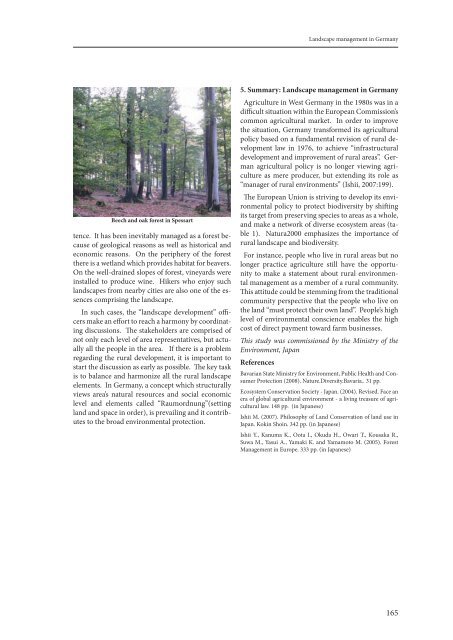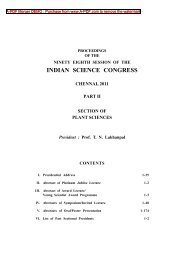sustainable use of biological diversity.pdf - India Environment Portal
sustainable use of biological diversity.pdf - India Environment Portal
sustainable use of biological diversity.pdf - India Environment Portal
Create successful ePaper yourself
Turn your PDF publications into a flip-book with our unique Google optimized e-Paper software.
Landscape management in Germany<br />
beech and oak forest in Spessart<br />
tence. It has been inevitably managed as a forest beca<strong>use</strong><br />
<strong>of</strong> geological reasons as well as historical and<br />
economic reasons. On the periphery <strong>of</strong> the forest<br />
there is a wetland which provides habitat for beavers.<br />
On the well-drained slopes <strong>of</strong> forest, vineyards were<br />
installed to produce wine. Hikers who enjoy such<br />
landscapes from nearby cities are also one <strong>of</strong> the essences<br />
comprising the landscape.<br />
In such cases, the “landscape development” <strong>of</strong>ficers<br />
make an effort to reach a harmony by coordinating<br />
discussions. The stakeholders are comprised <strong>of</strong><br />
not only each level <strong>of</strong> area representatives, but actually<br />
all the people in the area. If there is a problem<br />
regarding the rural development, it is important to<br />
start the discussion as early as possible. The key task<br />
is to balance and harmonize all the rural landscape<br />
elements. In Germany, a concept which structurally<br />
views area’s natural resources and social economic<br />
level and elements called “Raumordnung”(setting<br />
land and space in order), is prevailing and it contributes<br />
to the broad environmental protection.<br />
© JWRC<br />
5. Summary: landscape management in germany<br />
Agriculture in West Germany in the 1980s was in a<br />
difficult situation within the European Commission’s<br />
common agricultural market. In order to improve<br />
the situation, Germany transformed its agricultural<br />
policy based on a fundamental revision <strong>of</strong> rural development<br />
law in 1976, to achieve “infrastructural<br />
development and improvement <strong>of</strong> rural areas”. German<br />
agricultural policy is no longer viewing agriculture<br />
as mere producer, but extending its role as<br />
“manager <strong>of</strong> rural environments” (Ishii, 2007:199).<br />
The European Union is striving to develop its environmental<br />
policy to protect bio<strong>diversity</strong> by shifting<br />
its target from preserving species to areas as a whole,<br />
and make a network <strong>of</strong> diverse ecosystem areas (table<br />
1). Natura2000 emphasizes the importance <strong>of</strong><br />
rural landscape and bio<strong>diversity</strong>.<br />
For instance, people who live in rural areas but no<br />
longer practice agriculture still have the opportunity<br />
to make a statement about rural environmental<br />
management as a member <strong>of</strong> a rural community.<br />
This attitude could be stemming from the traditional<br />
community perspective that the people who live on<br />
the land “must protect their own land”. People’s high<br />
level <strong>of</strong> environmental conscience enables the high<br />
cost <strong>of</strong> direct payment toward farm businesses.<br />
This study was commissioned by the Ministry <strong>of</strong> the<br />
<strong>Environment</strong>, Japan<br />
references<br />
Bavarian State Ministry for <strong>Environment</strong>, Public Health and Consumer<br />
Protection (2008). Nature.Diversity.Bavaria.. 31 pp.<br />
Ecosystem Conservation Society - Japan. (2004). Revised. Face an<br />
era <strong>of</strong> global agricultural environment - a living treasure <strong>of</strong> agricultural<br />
law. 148 pp. (in Japanese)<br />
Ishii M. (2007). Philosophy <strong>of</strong> Land Conservation <strong>of</strong> land <strong>use</strong> in<br />
Japan. Kokin Shoin. 342 pp. (in Japanese)<br />
Ishii Y., Kanuma K., Oota I., Okuda H., Owari T., Kousaka R.,<br />
Suwa M., Yasui A., Yamaki K. and Yamamoto M. (2005). Forest<br />
Management in Europe. 333 pp. (in Japanese)<br />
165
















